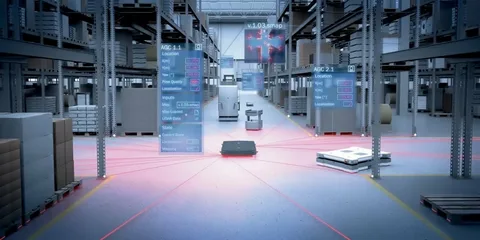In the world of robotics and autonomous systems, intelligent navigation is essential for success. Traditional GPS-based or pre-mapped guidance systems often fall short in complex or dynamic environments. This is where Vision SLAM (Simultaneous Localization and Mapping) steps in—a breakthrough technology that enables machines to build a real-time map of their surroundings while determining their own location using visual data. From drones and autonomous vehicles to industrial robots and AR systems, Vision SLAM is transforming how machines perceive and navigate the world. If you’re looking to integrate high-performance SLAM technology into your systems, you can explore advanced solutions at mrdvs.com/cv-slam.
In this article, we’ll explore what Vision SLAM is, how it works, its applications across various industries, the benefits it offers, and why it’s becoming essential in modern automation and robotics.
What Is Vision SLAM?
Vision SLAM, or Visual Simultaneous Localization and Mapping, is a technique that enables a device—like a robot, drone, or AR headset—to build a map of an unknown environment while simultaneously tracking its position within that space using visual sensors, such as monocular, stereo, or RGB-D cameras.
Unlike systems that depend on external inputs like GPS or LIDAR, Vision SLAM relies on visual cues extracted from the environment. This makes it ideal for indoor, underground, or GPS-denied spaces, as it doesn’t require prior knowledge of the environment.
Vision SLAM performs two tasks at once:
- Localization – Understanding where the device is in space.
- Mapping – Constructing a 3D or 2D map of the environment in real time.
These two functions run simultaneously and interdependently, making Vision SLAM uniquely powerful for mobile autonomy.
How Does Vision SLAM Work?
At its core, Vision SLAM is a loop of continuous sensing, computation, and correction. Here’s how it generally works:
- Image Capture
Cameras (monocular, stereo, or depth-sensing) record continuous visual input as the device moves through the environment. - Feature Detection and Matching
The system identifies visual features—like corners, edges, or textures—and tracks them across successive frames to estimate motion. - Motion Estimation
The robot calculates its movement relative to previously seen features, which helps determine its position. - Mapping
Using the feature data and estimated motion, the system creates a map of the surrounding environment. - Loop Closure
When the system revisits a location, it recognizes the overlap, correcting any accumulated error in its path and improving the map’s accuracy.
This entire process is executed continuously and in real time, enabling the robot or device to act intelligently within dynamic, changing environments.
Types of Vision SLAM Systems
There are multiple types of Vision SLAM based on the kind of visual input used:
| SLAM Type | Sensor Used | Common Use Case |
| Monocular SLAM | Single camera | Drones, small robots, AR applications |
| Stereo SLAM | Dual cameras | Depth estimation in robots and vehicles |
| RGB-D SLAM | Color + depth camera | Indoor robots, mobile mapping, AR/VR systems |
| Visual-Inertial SLAM | Camera + IMU (sensor) | High-speed drones, augmented reality |
Each type balances different trade-offs between cost, accuracy, processing needs, and real-time capability.
Key Applications of Vision SLAM
1. Robotics and Automation
Vision SLAM empowers mobile robots to navigate unfamiliar spaces without external beacons or GPS. Whether it’s warehouse robots navigating aisles or inspection bots moving through factories, Vision SLAM ensures flexibility and precision.
2. Drones and UAVs
For drones operating indoors or in GPS-blocked zones, Vision SLAM offers a reliable navigation system. It helps avoid obstacles, follow dynamic paths, and carry out mapping or delivery missions with accuracy.
3. Augmented and Virtual Reality
AR and VR systems rely heavily on spatial understanding. Vision SLAM allows headsets and smart glasses to track user movement and place digital elements accurately in the physical world, creating more immersive experiences.
4. Autonomous Vehicles
Vision SLAM adds an extra layer of environmental perception to self-driving cars, enhancing safety and enabling better navigation in areas with poor GPS coverage or ambiguous road conditions.
5. Industrial Inspection
Robots equipped with Vision SLAM can autonomously inspect industrial assets like pipelines, storage tanks, and structural frameworks, creating real-time 3D maps for maintenance planning.
Benefits of Vision SLAM
Vision SLAM has emerged as one of the most valuable tools in autonomous technology. Here’s why:
- Works Without GPS
SLAM systems operate independently of GPS, making them ideal for indoor or subterranean environments. - Lower Cost Sensors
Vision SLAM uses cameras, which are generally more affordable and lightweight compared to LIDAR or radar. - Real-Time Mapping
It builds and updates maps on the fly, allowing devices to navigate changing or previously unexplored environments. - High Spatial Accuracy
Vision SLAM provides centimeter-level precision, especially when combined with inertial measurement units (IMUs). - Scalability
Because it’s software-driven, Vision SLAM can be deployed across a range of devices—from smartphones to industrial robots.
Vision SLAM vs. Other Mapping Technologies
| Feature | Vision SLAM | LIDAR SLAM | GPS Navigation |
| Sensor Type | Camera-based | Laser-based | Satellite-based |
| Indoor Usability | Yes | Yes | No |
| Cost | Low | High | Moderate |
| Environmental Detail | High | Medium | Low |
| Dependence on Infrastructure | No | No | Yes |
| Real-Time Capable | Yes | Yes | Limited indoors |
While LIDAR and GPS have their advantages, Vision SLAM offers a flexible and economical solution for real-time, intelligent navigation.
Technologies Powering Vision SLAM
Vision SLAM leverages several advanced technologies to function efficiently:
- Computer Vision Algorithms – For identifying and tracking features across frames.
- Simultaneous Estimation – SLAM algorithms solve for location and mapping together.
- Sensor Fusion – Often paired with inertial sensors to enhance accuracy in low-texture environments.
- Loop Closure Detection – Recognizes previously visited spots and refines map accuracy.
- AI and Deep Learning – Used in advanced SLAM systems to improve robustness and deal with complex environments.
Challenges in Vision SLAM
Despite its many advantages, Vision SLAM is not without challenges:
- Lighting Sensitivity: Poor lighting or high contrast can affect image quality and tracking accuracy.
- Computational Demands: Real-time operation requires powerful processors or GPUs.
- Textureless Environments: Rooms with blank walls or repetitive patterns can be difficult for visual systems.
- Drift: Over time, small positioning errors may accumulate unless corrected by loop closure.
Fortunately, these limitations are being addressed through AI-enhanced mapping, improved cameras, and hybrid systems that combine vision with other sensing modalities.
Future Trends in Vision SLAM
As technology progresses, the Vision SLAM landscape is also evolving rapidly:
- Neural SLAM: Using deep learning to improve map building and motion estimation.
- Cloud SLAM: Sharing spatial data in the cloud for collaborative robots and smart environments.
- Edge AI: Processing SLAM data on edge devices for lower latency and faster reactions.
- Multi-Agent SLAM: Coordinating multiple robots to build large maps faster and more accurately.
- SLAM in IoT: Integration with smart devices for spatial awareness in smart homes and cities.
These innovations are positioning Vision SLAM as a foundational technology in the next generation of intelligent, autonomous systems.
Getting Started with Vision SLAM
If you’re ready to deploy Vision SLAM, here are key steps to consider:
- Define the Use Case – Indoor robot navigation, AR experience, drone mapping, etc.
- Select Camera Type – Choose from monocular, stereo, or RGB-D based on your needs.
- Choose Processing Platform – Ensure your hardware supports the computational load.
- Test in Controlled Settings – Simulate real environments before full deployment.
- Partner with Experts – Work with providers who specialize in vision SLAM to accelerate your integration.
Conclusion
Vision SLAM is a transformative technology that gives machines the ability to understand and navigate the world intelligently using visual data. It enables everything from autonomous robots and drones to immersive AR experiences, all without relying on GPS or pre-built maps.
With its low cost, real-time capabilities, and scalable design, Vision SLAM is becoming an essential part of modern robotics and automation systems. As industries seek smarter, more adaptable solutions, the demand for Vision SLAM is only set to grow.
If you’re considering Vision SLAM for your business or product, don’t miss the opportunity to explore innovative solutions tailored for real-world performance at mrdvs.com/cv-slam.


